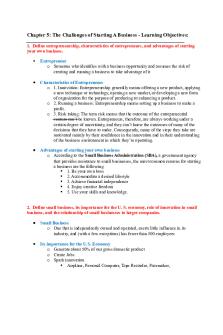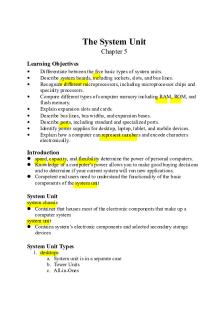Chapter 5 Notes PDF

| Title | Chapter 5 Notes |
|---|---|
| Author | Jake Safford |
| Course | Econ of Global Money Markets |
| Institution | Wright State University |
| Pages | 7 |
| File Size | 366.1 KB |
| File Type | |
| Total Downloads | 79 |
| Total Views | 136 |
Summary
Chapter 5 of EC3010, had Hee Young Shin but can use for any teacher....
Description
Determinants of Asset Demand • Wealth: the total resources owned by the individual, including all assets • Expected Return: the return expected over the next period on one asset relative to alternative assets • Risk: the degree of uncertainty associated with the return on one asset relative to alternative assets • Liquidity: the ease and speed with which an asset can be turned into cash relative to alternative assets Theory of Portfolio Choice Holding all other factors constant: 1. The quantity demanded of an asset is positively related to wealth 2. The quantity demanded of an asset is positively related to its expected return relative to alternative assets 3. The quantity demanded of an asset is negatively related to the risk of its returns relative to alternative assets 4. The quantity demanded of an asset is positively related to its liquidity relative to alternative assets Supply and Demand in the Bond Market • At lower prices (higher interest rates), ceteris paribus, the quantity demanded of bonds is higher: an inverse relationship • At lower prices (higher interest rates), ceteris paribus, the quantity supplied of bonds is lower: a positive relationship Price of Bonds, P ($) 1,000 (i = 0%) 950 (i = 5.3%)
Bs
With excess supply, the bond price falls to P * A
I
900 (i = 11.1%)
B
H C
P * = 850 (i* = 17.6%) 800 (i = 25.0%) 750 (i = 33.0%)
D
G
F
With excess demand, the bond price rises to P *
E Bd
100
200
300
400
500
Quantity of Bonds, B ($ billions)
Market Equilibrium • Occurs when the amount that people are willing to buy (demand) equals the amount that people are willing to sell (supply) at a given price • Bd = Bs defines the equilibrium (or market clearing) price and interest rate. • When Bd > Bs , there is excess demand, price will rise and interest rate will fall • When Bd < Bs , there is excess supply, price will fall and interest rate will rise Changes in Equilibrium Interest Rates • Shifts in the demand for bonds:
– Wealth: in an expansion with growing wealth, the demand curve for bonds shifts to the right – Expected interest rates: higher expected interest rates in the future lower the expected return for long-term bonds, shifting the demand curve to the left – Expected Inflation: an increase in the expected rate of inflations lowers the expected return for bonds, causing the demand curve to shift to the left – Risk: an increase in the riskiness of bonds causes the demand curve to shift to the left – Liquidity: increased liquidity of bonds results in the demand curve shifting right Shift in the Demand Curve for Bonds Price of Bonds, P
A′
An increase in the demand for bonds shifts the bond demand curve rightward.
A B′ B C′ C D′ D
E′ E
B
d 1
B
d 2
Quantity of Bonds, B
Shifts in the Demand of Bonds
Shifts in the Supply of Bonds • Shifts in the supply for bonds: – Expected profitability of investment opportunities: in an expansion, the supply curve shifts to the right – Expected inflation: an increase in expected inflation shifts the supply curve for bonds to the right – Government budget: increased budget deficits shift the supply curve to the right
Shift in the Supply Curve for Bonds Price of Bonds, P
B
B
s 1
s 2
I I′ H H′ C C′ G
An increase in the supply of bonds shifts the bond supply curve rightward.
G′ F F′
Quantity of Bonds, B
Response to a Change in Expected Inflation Price of Bonds, P
B 1s B 2s Step 1. A rise in expected inflation shifts the bond demand curve leftward . . . 1
Step 2. and shifts the bond supply curve rightward . . .
P1
Step 3. causing the price of bonds to fall and the equilibrium interest rate to rise.
2 P2
B 2d Quantity of Bonds, B
B 1d
Response to a Business Cycle Expansion Price of Bonds, P
B 1s B
s 2
Step 1. A business cycle expansion shifts the bond supply curve rightward . . . Step 2. and shifts the bond demand curve rightward, but by a lesser amount . . .
1 P1
Step 3. so the price of bonds falls and the equilibrium interest rate rises.
2
P2
B 1d
B d2
Quantity of Bonds, B
Equilibrium in the Market for Money Interest Rate, i (%) 30
Ms A
With excess supply, the interest rate falls to i *.
25
B
20
C
i * =15
D
10
E
5
Md 0
100
200
300
400
500
With excess demand, the interest rate rises to i *.
600
Quantity of Money, M ($ billions)
Supply and Demand in the Market for Money: The Liquidity Preference Framework • Demand for money in the liquidity preference framework: – As the interest rate increases: • The opportunity cost of holding money increases… • The relative expected return of money decreases… – …and therefore the quantity demanded of money decreases. • Shifts in the demand for money: – Income Effect: a higher level of income causes the demand for money at each interest rate to increase and the demand curve to shift to the right – Price-Level Effect: a rise in the price level causes the demand for money at each interest rate to increase and the demand curve to shift to the right • Shifts in the supply of money:
– Assume that the supply of money is controlled by the central bank. – An increase in the money supply engineered by the Federal Reserve will shift the supply curve for money to the right.
Response to a Change in Income or the Price Level Interest Rate, i
Ms
Step 1. A rise in income or the price level shifts the money demand curve rightward . . .
2
i2
Step 2. and the equilibrium interest rate rises.
i1
1
d
M2 M1d
M
Quantity of Money, M
Response to a Change in the Money Supply s
Interest rates, i
M2
M1
s
1
Step 2. and the equilibrium interest rate falls.
i1
i2
2
M
d
Quantity of Money, M
Money and Interest Rates • A one time increase in the money supply will cause prices to rise to a permanently higher level by the end of the year. The interest rate will rise via the increased prices. • Price-level effect remains even after prices have stopped rising. • A rising price level will raise interest rates because people will expect inflation to be higher over the course of the year. When the price level stops rising, expectations of inflation will return to zero. • Expected-inflation effect persists only as long as the price level continues to rise. Does a Higher Rate of Growth of the Money Supply Lower Interest Rates? • Liquidity preference framework leads to the conclusion that an increase in the money supply will lower interest rates: the liquidity effect. • Income effect finds interest rates rising because increasing the money supply is an expansionary influence on the economy (the demand curve shifts to the right). • Price-Level effect predicts an increase in the money supply leads to a rise in interest rates in response to the rise in the price level (the demand curve shifts to the right). • Expected-Inflation effect shows an increase in interest rates because an increase in the money supply may lead people to expect a higher price level in the future (the demand curve shifts to the right).
Response over Time to an Increase in Money Supply Growth Interest Rate, i
i1 i2 (a) Liquidity effect larger than other effects
T Time Liquidity Income, Price-Level, and ExpectedEffect
Inte
M
M 1s
In te re s t ra te s , i
s 2
1
i1
S te p 2 . a n d th e e q u ilib r iu m in te r e s t r a t e fa lls .
iquidity effect smaller than ther effects and slow adjustment f expected inflation
2
i2
M
d
Int Q u a n t it y o f M o n e y , M
i1
(c) Liquidity effect smaller than expected-inflation effect and fast adjustment of expected inflation
T Time Liquidity and expectedinflation Effect
Income and PriceLevel Effects...
Similar Free PDFs

Chapter 5 - Lecture notes 5
- 15 Pages

Chapter-5 - Lecture notes 5
- 6 Pages

Chapter 5 - Lecture notes 5
- 83 Pages

Chapter 5 - Lecture notes 5
- 4 Pages

Chapter 5 - Lecture notes 5
- 20 Pages

Chapter 5 - Lecture notes 5
- 4 Pages

Chapter 5 - Lecture notes 5
- 7 Pages

Chapter 5 - Lecture notes 5
- 2 Pages

Chapter 5 - Lecture notes 5
- 3 Pages

Chapter 5 - Lecture notes 5
- 2 Pages

Chapter 5 - Lecture notes 5
- 6 Pages

Chapter 5 - Lecture notes 5
- 6 Pages

Chapter+5 - notes for chapter 5
- 8 Pages

Chapter 5 Notes 4e
- 12 Pages

Chapter 5 Notes
- 15 Pages

Chapter notes 1-5
- 72 Pages
Popular Institutions
- Tinajero National High School - Annex
- Politeknik Caltex Riau
- Yokohama City University
- SGT University
- University of Al-Qadisiyah
- Divine Word College of Vigan
- Techniek College Rotterdam
- Universidade de Santiago
- Universiti Teknologi MARA Cawangan Johor Kampus Pasir Gudang
- Poltekkes Kemenkes Yogyakarta
- Baguio City National High School
- Colegio san marcos
- preparatoria uno
- Centro de Bachillerato Tecnológico Industrial y de Servicios No. 107
- Dalian Maritime University
- Quang Trung Secondary School
- Colegio Tecnológico en Informática
- Corporación Regional de Educación Superior
- Grupo CEDVA
- Dar Al Uloom University
- Centro de Estudios Preuniversitarios de la Universidad Nacional de Ingeniería
- 上智大学
- Aakash International School, Nuna Majara
- San Felipe Neri Catholic School
- Kang Chiao International School - New Taipei City
- Misamis Occidental National High School
- Institución Educativa Escuela Normal Juan Ladrilleros
- Kolehiyo ng Pantukan
- Batanes State College
- Instituto Continental
- Sekolah Menengah Kejuruan Kesehatan Kaltara (Tarakan)
- Colegio de La Inmaculada Concepcion - Cebu